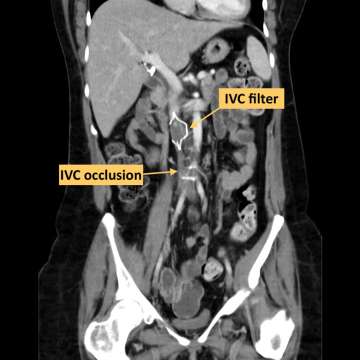Questions and Answers
Find your care
Our clinic is nationally and internationally renowned for IVC filter removal. Call 310-481-7545 to learn more about the IVC Filter Clinic at UCLA Health.
- What is an IVC Filter?
An inferior vena cava (IVC) filter is a small metallic medical device inserted for the prevention of pulmonary embolism (PE). It operates by blocking the movement of clots from where they form in the legs (DVT) to the heart and lungs (PE).
- I’ve had one procedure to remove my IVC filter and failed. Is it possible it can still be removed?
This is one of the most common questions our dedicated filter clinic staff get asked. Yes, it is frequently possible that an IVC filter can be removed after a failed attempt. Along with the expertise and experience of our physicians there are many advanced techniques that allow us to remove your IVC filter, even if others have failed. Each individual patient is evaluated on a case by case bases to determine best treatment option.
- If my filter has been in place for years can it still be removed?
We have removed IVC filters that have been in place for years, and in several cases, decades. With advanced techniques it is possible to remove a filter that has been in place for years. With our multidisciplinary approach each patient is evaluated with a few simple questions such as: type of filter, approximate filter placement. If information is unavailable, patients will work with our clinical coordinator to answer questions.
- My IVC Filter was not placed in UCLA, can it still be removed in UCLA?
Yes. Often we see patients that are referred by other physicians outside of UCLA. Our clinic team will work with you to gather information that is needed and set up the filter removal.
- What are the things that can go wrong with an IVC Filter?

- IVC Filter Fracture:
The legs of the IVC can break off - IVC Penetration:
Parts of the IVC Filter can work their way into and through the wall of the blood vessel - IVC Thrombosis:
Clot can form in the IVC around the filter and block flow, leading to leg swelling, pain and immobility. - IVC Occlusion:
When clot around the IVC filter remains there for an extended period it can lead to a complete permanent blockage of the IVC, also known as IVC occlusion. This leads to long term leg swelling, pain and immobility - DVT:
Blood clots can form within the legs - IVC Filter Embolization:
The filter itself, or parts of it, can move to the heart and lungs and may potentially cause serious problems
- IVC Filter Fracture:
- Once I’ve set up my IVC filter removal procedure, where do I send my information such as medical records?
Please send all records and images to:
UCLA IVC Filter Clinic
Phone: (310) 481-7545
Fax: (310) 794-9070
100 UCLA Medical Plaza, Suite 100
Los Angeles, CA 90095 - Should I stop my current blood thinning medication?
In most cases we do not require you to change your blood thinner regimen. Your IVC filter clinic coordinator will review your medications you are taking and will determine whether or not you should continue taking them before your procedure.
- How long will I be in the hospital?
In most cases patients will be at in the hospital between 3-4 hours for either IVC filter placement or removal procedures. In rare cases patients stay overnight for observation depending on individual circumstances.
Our expert team will work to answer all questions leading up to the procedure as well as what to expect during recovery.
If you are coming from out of town it is a good idea to wait at least 48 hours after the procedure before taking a flight or driving long distances.
- Where can I stay near the hospital?
Patients and their families frequently travel to UCLA for their clot and filter care. For out-of-town patients and visiting family members, UCLA recommends:

- Will my insurance cover the procedure?
Most insurance cover the IVC filter placement and removal procedures. The IVC filter clinic team can work with you and your insurance company to determine if you will receive coverage
Dr. John Moriarty discusses IVC filters, reasons to insert and retrieve them, and up to date minimally invasive methods of removing them.